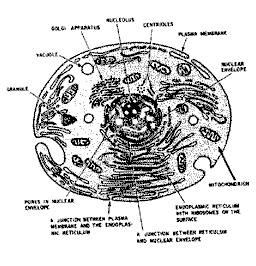 |
Science Frontiers ONLINE No. 91: Jan-Feb 1994 |
|
|
Dna Undermines Key Paradigms
Lately, the Wall Street Journal has expanded its coverage from stocks and bonds to the Marfa lights and other scientific anomalies. Now, it is challenging archeological sacred cows using mitochondrial DNA. Quite a switch from pork futures! Of course, the WSJ is not a recognized scientific source, but its reporter did get his information directly from D.C. Wallace, a well-known professor of genetics and molecular medicine at Emory University and a champion of the African Eve theory.
 Surely an unusual illustration for the archeology section, but the DNA in these mitochondria may upset long-held theories of human migration. |
Anyway, Wallace has been studying mitochondria, those little energizers in human and animal cells. Strangely, mitochondria have their own DNA, which is separate and distinct from the nuclear DNA that directs other biological processes. Mitochondrial DNA has had its own history of evolution and is different for various human populations. Wallace has used this fact to trace the origins of American Indians by comparing their mitochondrial DNA with that from Asians, Africans, etc. His conclusions are controversial to say the least.
- The Amerinds, who comprise most of the Native Americans, arrived in a single migratory wave 20,000-40,000 years ago -- not merely 12,000 years ago!
- Native Siberians lack a peculiar mutation of mitochondrial DNA that appeared in the Amerinds 6,000-10,000 years ago, casting doubt on the Siberian land bridge theory. Instead, this particular mutation is found in Southeast Asia, Melanesia, and Polynesia.
- The Navajos, Apaches, and other so-called Na-Dene peoples entered North America a mere 5,000-10,000 years ago. The article does not say from where.
(Bishop, Jerry E.; "A Geneticist's Work on DNA Bears Fruit for Anthropologists," Wall Street Journal, November 10, 1993. Thanks to several people who telephoned or sent along this article.)